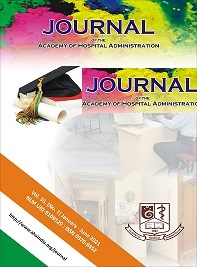RELATING ORGANIZATION STRUCTURE OF HOSPITALS TO ITS STRATEGY:ASE STUDY OF TWO HOSPITALS IN INDIA
Abstract
Background:
Healthcare in India is very important. With 1.3 billion population to cater, it is huge task. And most important is service offered to patients in India. So many hospitals have come up and there is need to give right organization structure to hospital so that we have more satisfied patients.
To survive, each hospital needs to have a unique strategy (or a USP: unique selling proposition) that gives it competitive advantage. These strategies have been categorized in literature as cost leadership (CLH) or differentiation (DIFFH). A cost leader hospital (CLH) gives health services at least possible cost whereas a hospital with differentiation strategy (DIFFH) gives better healthcare at a higher cost (typically to higher income class group patients). An example is CLH may give ‘generic’ drugs whereas a DIFFH may give ‘non-generic’ drug; a DIFFH may serve tailor made food to cater to the nutrition needs of patients, and so on.
Objectives:
Here we give relationship between strategy and structure of hospitals having different strategies, i.e., pure cost leadership (CLH) and pure differentiation (DIFFH) by a simple theoretical argument. And we wish to see if it is valid in real life by. For this we conduct a pilot study of one CLH and one DIFFH in Kanpur city.
Study Design:
In administration, structure has been reported to be measured on five dimensions: standardization, specialization, centralization, formalization and complexity of work flow CWF (see Pugh et al. 1968).
We show that these structure dimensions have different values for hospitals having different strategies (CLH and DIFFH). Formalization is high in both CLH and DIFFH hospitals; and this may be due to increased emphasis on ‘evidence based treatment’ in the healthcare and also to keep a record of treatments given to patients to take care of any future litigations. Also we note that specialization is low in CLH hospitals and is high in DIFFH hospitals. Specialization in CLH hospitals is very low where as it is very high in super specialty hospitals. This is totally different than the framework provided for strategy and structure for manufacturing and services by Miles and Snow (1978).
For CLH hospitals the standardization, centralization continues to be high; and CWF is low. For DIFFH hospitals the standardization and centralization is low and CWF is high. This is same as the framework provided for strategy and structure for manufacturing and services by Miles and Snow (1978).
Study Setting:
We do extensive literature review in the field of administration to identify the research gap. Later we give our theoretical arguments that are different ones than given in literature. A small study of 2 hospitals is undertaken to give support to our propositions.
Materials and Methods:
In order to verify our theoretical framework we conducted a pilot study of two hospitals in Kanpur. One of them was a CLH and the other one was DIFFH. Strategies pursued were observed. Structure was observed by several visits to these two hospitals as observer and as patient.
Results and Conclusions:
We found that the cost leader hospital in our sample had high standardization and high centralization; and low complexity of workflow. And the hospital with differentiation strategy had high standardization and centralization; and low complexity of workflow. This is as per the framework available in literature (Miles and Snow 1978).
We found that the cost leader hospital in our sample had high formalization and low specialization. And the hospital with differentiation strategy had high formalization and high specialization. This is contrary to the framework available in literature (Miles and Snow 1978). This is the new theoretical contribution we make.
These findings have important implications for hospital administration. It will help management of hospitals to choose right structure (for hospitals) that is aligned to their strategies so that the patients get the most efficient and effective healthcare.






